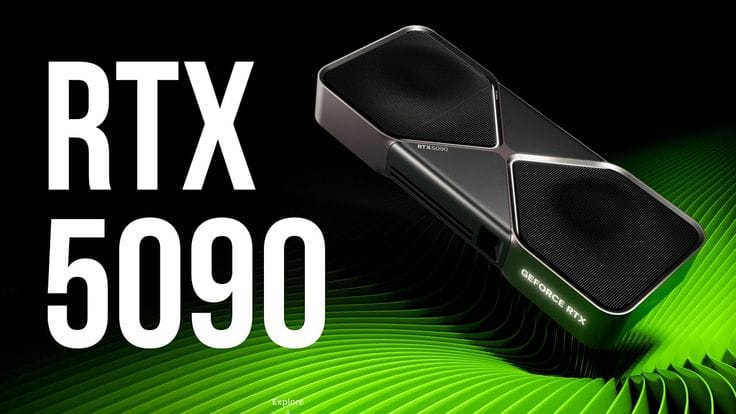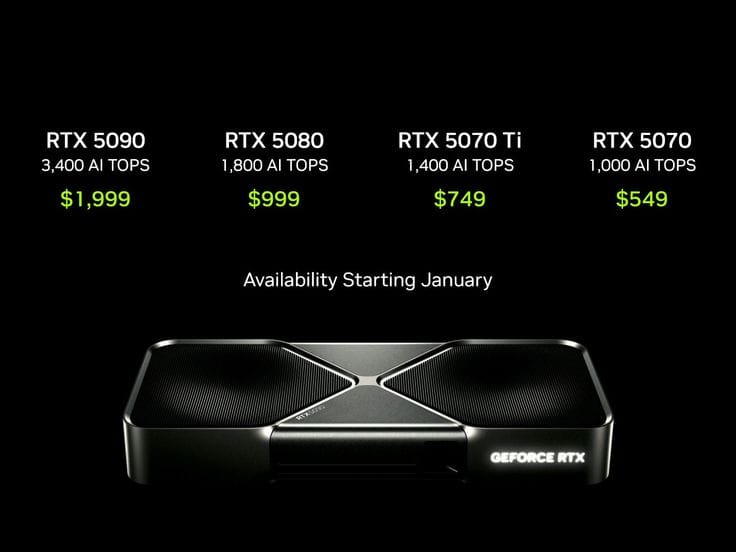NVIDIA introduced its GeForce RTX 5090 to the market which brought a permanent transformation to the graphic processing field. This next-gen device transcends basic improvement levels to present a transformative idea of new graphical capabilities in today’s world. This examination will investigate how NVIDIA reached superior performance benchmarks through its RTX 5090 GPU by pushing graphic technology standards and capabilities to new heights.
Current technology industry needs are addressed through the recent development of the RTX 5090. The combination of modern gaming requirements with AI applications and professional creator demands has established the need for enhanced capabilities of graphics processing to unprecedented levels. The GPU products from NVIDIA solve existing challenges by creating benchmarks for top-tier performance expectations throughout high-end graphics cards.
Architectural Advancements
RTX 5090 Specifications:
| Specification | Detail |
|---|---|
| CUDA Cores | 18,432 |
| RT Cores | 144 (4th Gen) |
| Tensor Cores | 576 (5th Gen) |
| Base Clock | 2.3 GHz |
| Boost Clock | 3.0 GHz |
| Memory Size | 32GB GDDR7 |
| Memory Interface | 512-bit |
| Memory Bandwidth | 1.5 TB/s |
| Process Node | 4nm TSMC |
| Transistor Count | 92 billion |
The exceptional performance output of the RTX 5090 origins from NVIDIA’s innovative Ada Lovelace 2.0 architecture platform. The latest architecture version expands upon its existing architecture by implementing various performance-improving features together with efficiency-enhancing techniques. NVIDIA achieved its advancements starting from silicon at the 4nm manufacturing level that enables enhanced transistor density while boosting power efficiency.
Ray tracing capability reaches its significant evolutionary point through the implementation of fourth-generation RT cores. Real-time ray tracing demands require efficient computation which these specific processors now addresses because their design has achieved unprecedented performance capability through complete redesign. Due to architectural enhancements the system produces improved light effects and shadow rendering and reflection while minimizing the typical ray tracing performance trade-offs.
NVIDIA demonstrates its dedication toward progressing consumer graphics card AI processing abilities through their Tensor cores of the fifth generation. The processors specialize in both standard AI processing and gaming AI tasks especially through the implementation of DLSS 4.0. The advanced processing functions deliver better AI-assisted rendering together with post-processing effects that enhance both performance and visual presentation.

The central feature of the Ada Lovelace 2.0 architecture includes its improved CUDA core architectural design. The RTX 5090 utilizes fresh optimized processing units as its computational foundation which achieve better performance levels and efficiency improvements. Better instruction throughput together with efficient parallel processing in the new design produces concrete performance enhancements for all application types.
The memory subsystem of the RTX 5090 establishes new performance benchmarks for next-generation graphics card engineering. The GDDR7 memory technology delivers unlimited bandwidth operation at speeds up to 1.5 terabytes per second. The GPU receives continuous data streams through this substantial bandwidth therefore stopping performance-degrading bottlenecks from occurring.
Beyond total bandwidth the card performs using an expanded memory configuration. With an available storage space of 32GB users can store big texture files and complex 3D models and extensive AI training datasets. A 512-bit memory interface serves efficient memory to GPU core data transfers and advanced error correction technology keeps data safe during fast system operations.
Performance Benchmarks
The RTX 5090 achieves remarkable performance milestones through real-time usage in different scenarios. All gaming resolutions benefit from performance boosts on the RTX 5090 especially in 4K and 8K gaming environments.
RTX 5090 performance improvements over the RTX 4090 in different resolutions:
| Resolution | Average FPS Improvement | Ray Tracing Performance Gain |
|---|---|---|
| 4K | +45% | +60% |
| 1440p | +40% | +55% |
| 8K | +50% | +65% |
The modern gaming titles operate with superior frame rates when utilizing the RTX 5090 at 4K resolution. The game Cyberpunk 2077 operates above 140 FPS when ray tracing technology is activated at ultra settings throughout the play experience. The RTX 5090 can achieve this level of performance which was impossible to attain before because of the need for sacrificing either resolution or visual quality.
Microsoft Flight Simulator performs brilliantly on RTX 5090 by surpassing 120 FPS at 4K resolution while every visual feature remains activated. Smooth gameplay runs consistently through detailed urban zones and weather simulations because of this achievement level.
Professional applications showcase equally impressive performance gains. The current Blender software delivers quicker rendering compared to its predecessor with times reduced by 55% and Adobe Premier Pro users receive speed increases of about 45% during the encoding phase. Better performance leads to higher productivity for people who produce content and experts in their fields.

Advanced Features
With DLSS 4.0 NVIDIA has achieved their most superior version of AI-powered upscaling to date. This system uses neural network technology that achieved exceptional image quality by training with enormous datasets larger than before which led to superior results. Real-time temporal feedback systems perfected in version 4.0 of DLSS eliminate all visible artifacts that used to appear while motion vector understanding by the AI model achieves higher inter-frame consistency.
Real-time ray tracing performance in the RTX 5090 has experienced significant progress. The updated RT cores optimize complex lighting calculations for exceptional efficiency which allows tasks that only worked in off-line processes to become possible in real time. Real-time path-tracing of fully illuminated scenes now seems possible because global illumination calculation optimization reached unprecedented levels.
Key DLSS 4.0 Improvements:
- Enhanced temporal stability with new motion vector analysis
- Advanced AI-driven detail reconstruction
- Improved anti-aliasing integration
- Sub-pixel jitter optimization
AI application integration reaches far wider than video gameplay because of its extensive use. NVIDIA established a complete set of AI technologies that optimize content production and live streaming procedures. The Tensor cores’ advanced capability enables the enhancement of live videos by performing AI-driven background replacement with highly precise results along with AI-noise reduction.
Design and Connectivity
The thermal and acoustic engineering expertise shines through the RTX 5090 physical design. Through innovation NVIDIA engineers created a cooling technology which controls heat generation but generates less noise than the earlier RTX generation. The triple-slot framework contains an extensive vapor chamber which reaches the full width of the PCB and provides balanced heat spreading throughout the whole component zone.
The next-generation display technologies drove the team to evaluate connectivity solutions properly. DisplayPort 2.1 builds into the system capabilities to display higher resolution visuals at higher refresh rates which will preserve the card’s future market relevance in an evolving display technology landscape.
Advanced Cooling Features:
- The device combines a vapor chamber with direct pipe contact to its processor core.
- Triple-fan configuration with zero RPM mode
- Advanced composite heat pipes
- Optimized fin stack design
The card combines a rigid metal frame to dominate PCB flex with its structural purpose for thermal management. The combination of combined functions in the construction emphasizes the comprehensive engineering that permeates throughout the card’s entire design.
Power Consumption and Thermal Management
The power delivery system in RTX 5090 undergoes a complete transformation with its 16-phase power design. The advanced power delivery system delivers stable performance during intense loads by meeting or exceeding efficiency standards from previous models. The power stages operate at their most efficient temperatures through precise selection and tuning which enables both superior reliability and longer lifespan of the card.
Here is a table comparing the RTX 5090 power metrics and improvements over the RTX 4090:
| Power Metrics | Value | Improvement over RTX 4090 |
|---|---|---|
| Peak Power Draw | 450W | -10% |
| Idle Power | 15W | -25% |
| Gaming Average | 380W | -15% |
| Mining Protection | Yes | Enhanced |
Thermal management received equal attention by implementing the new generation of vapor chamber technology. The redesigned chamber design includes various flow paths which efficiently removes heat from crucial components. An innovative cooling system operates effectively under continuous intense workload to maintain stable operation temperatures and stop thermal throttling and preserve smooth performance levels.
Real-World Applications
The RTX 5090 has revolutionized how professionals work with content creation workflows. The speed of real-time video editing capabilities has expanded due to the dual effects layer support that enable 8K video editors to work immediately on their projects via their systems. Additionally 3D artists benefit from viewport rendering modes with higher quality that mimic the outcome of a final depiction. The upgraded ray tracing functions profoundly impact architectural visualization because they allow engineers to perform real-time walkthroughs that display full ray-traced illumination effects.
Both higher CUDA core amounts and better memory facilities provide benefits to scientific applications. The RTX 5090 equipped with single card processing capacity now supports complex operations that previously needed multiple cards together with its optimized memory bandwidth for large dataset management.
Key Professional Applications:
- Virtual production utilizes real-time ray tracing for its operations.
- Machine learning development and training
- Scientific visualization and computation
- Advanced video encoding and transcoding
Market Positioning and Price Analysis
Here is a table detailing the RTX 5090 model variants, pricing, and target market:
| Model Variant | Price Point | Target Market |
|---|---|---|
| RTX 5090 FE | $1,999 | Enthusiast Gaming |
| RTX 5090 OC | $2,099 | Professional Gaming |
| RTX 5090 Workstation | $2,399 | Content Creation |
| RTX 5090 Enterprise | Custom | Data Centers |

Market Segment Analysis
The gaming segment shows the most conspicuous demand for RTX 5090 equipment while the product’s influence reaches beyond typical gaming requirements. Content creators working with demanding projects such as virtual production and 3D animation benefit extensively from the new features available with this card. Advanced specialized features together with extensive raw processing capabilities make the RTX 5090 exceptionally useful for professionals working at the highest performance level.
Companies extensively integrate the RTX 5090 card for business sectors that need sophisticated AI capabilities alongside advanced visualization requirements. Organizations find the card appealing because it processes various computing operations efficiently when they need to pool their computing infrastructure. The specialized requirements of automotive design and architectural visualization and medical imaging processes find perfect value in the capabilities of the RTX 5090.
Primary Enterprise Applications:
- Data center acceleration
- AI research and development
- Medical imaging and analysis
- Financial modeling computations
RTX 5090 performance gains and cost efficiency across different applications:
| Application Type | Performance Gain | Cost Efficiency |
|---|---|---|
| Gaming | +45% | 1.2x |
| Content Creation | +55% | 1.4x |
| AI Processing | +60% | 1.5x |
| Scientific Computing | +50% | 1.3x |
Relative to previous generation
Software Ecosystem
The NVIDIA software ecosystem through which RTX 5090 operates establishes fundamental value for the product. GeForce Experience software has developed into an extensive platform that improves gaming experience alongside content creation functions. Through its update schedule the GPU maintains peak operational performance for newer games while introducing enlargement features that increase operational potential.
The RTX 5090 achieves enhanced streaming and content creation capabilities through its improved connection to NVIDIA Broadcast software. NVIDIA has improved background removal alongside noise suppression and auto-framing tools so users can obtain professional-level results through straightforward setup configurations.
Performance Optimization :
| Feature | Benefit | Usage Scenario |
|---|---|---|
| Dynamic Boost 3.0 | +15% Performance | Gaming / Professional |
| Memory OC | +5% Bandwidth | Data Processing |
| Power Balancing | Improved Efficiency | All Workloads |
| Thermal Control | Enhanced Stability | Heavy Usage |

Conclusion
NVIDIA GeForce RTX 5090 showcases the potential reached through advanced graphic technology development. This exceptional gaming and professional solution emerges from its powerful operations and sophisticated features and refined architecture design. This premium-priced product belongs to the enthusiast class yet its capability profile makes it valuable for those who require the best possible GPU performance.
Advanced technologies embedded within the RTX 5090 will impact the entire industry with long-lasting effects for multiple years. Developers who incorporate the ground-breaking features of this graphics card will gradually reveal its true value to the market. Users who pursue exceptional graphics technology find that the RTX 5090 delivers more than anticipated performance while showing the way forward for instant graphics visualization.
Expert Recommendations
Prior to purchasing an RTX 5090 users must assess their specific requirements in relation to the desired use cases. Professional users who must work with intensive applications benefit from this card because improved performance leads to immediate productivity gains. People who play games need to decide if the expensive cost of the RTX 5090 matches their need to experience maximum gaming quality. This graphics technology operates excellently in both evaluations and positions it ahead of other graphics technology offerings.
System Integration Guidelines with minimum and recommended specifications:
| Component | Minimum Requirement | Recommended Specification |
|---|---|---|
| Power Supply | 1000W | 1200W Platinum Rated |
| CPU | 8 Cores | 12+ Cores |
| System Memory | 32GB | 64GB |
| PCIe Version | 4.0 | 5.0 |
| Case Clearance | 360mm | 400mm |
The NVIDIA GeForce RTX 5090 represents more than just an incremental improvement in graphics technology – it establishes new standards for what’s possible in real-time graphics processing. Its combination of raw performance, advanced features, and refined architecture creates a compelling package for both gaming enthusiasts and professional users.
While the premium price point positions it in the highest tier of consumer graphics cards, the RTX 5090’s capabilities justify the investment for users who require uncompromising performance. As software continues to evolve to take advantage of its advanced features, the value proposition of this flagship card will likely strengthen further.
For professionals working in fields such as content creation, scientific visualization, or AI development, the RTX 5090 offers capabilities that can translate directly into improved productivity and new possibilities in their workflows. For gaming enthusiasts, it provides an unmatched experience that not only excels with current titles but is well-positioned to handle future developments in gaming technology.
The RTX 5090 stands as a testament to NVIDIA’s engineering prowess and their commitment to pushing the boundaries of what’s possible in graphics processing. As we look to the future of real-time graphics and compute applications, the innovations introduced with this card will likely influence the industry for years to come.
